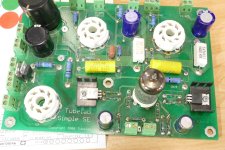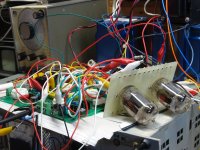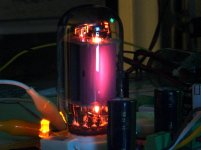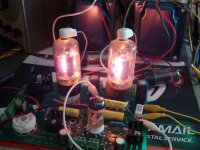Ethanol isn't going to work well on rosin flux, ethanol is too polar, and denatured ethanol is full of additives that may be an issue. Propanol is less polar.
you power-washed unsealed variable capacitor, unsealed pots, unsealed trim pots, unsealed IF transformers, etc.
😱
i'm impressed it powered up and found a station or 2.
🙂
😱

i'm impressed it powered up and found a station or 2.
🙂
In order to remove excess flux, I have a 4 step plan that works for me.
1. Wash excess flux along with an ESD brush (looks like a tooth brush and available on Amazon) using Chemtronics Flux-Off. This gets all the flux removed but leaves some residue. There are cheaper places that sell it, so shop around. Use Painters Tape to wrap up components that may be compromised (either electrically or due to the solvent that can remove labeling on electrolytic capacitors).
2. Immediately pour distilled water (room temperature) on the board, gently shaking off the excess water. I get my distilled water from our grocery store. $1/gallon.
3. Place the board on a wooden lazy Susan or equivalent, and use your hot air gun while spinning the lazy Susan and gently drying the board. The board should be fully dry in 5 minutes. Keep a good distance from the PCB so you don't overheat components, capacitors, etc...
4. Remove any excess flux/residue remaining with little sprays of the Chemtronics Flux Off and dab it with Kim Wipes.
Best,
Anand.
1. Wash excess flux along with an ESD brush (looks like a tooth brush and available on Amazon) using Chemtronics Flux-Off. This gets all the flux removed but leaves some residue. There are cheaper places that sell it, so shop around. Use Painters Tape to wrap up components that may be compromised (either electrically or due to the solvent that can remove labeling on electrolytic capacitors).
2. Immediately pour distilled water (room temperature) on the board, gently shaking off the excess water. I get my distilled water from our grocery store. $1/gallon.
3. Place the board on a wooden lazy Susan or equivalent, and use your hot air gun while spinning the lazy Susan and gently drying the board. The board should be fully dry in 5 minutes. Keep a good distance from the PCB so you don't overheat components, capacitors, etc...
4. Remove any excess flux/residue remaining with little sprays of the Chemtronics Flux Off and dab it with Kim Wipes.
Best,
Anand.
I just have to add the following experience about what someone deemed as a good idea for cleaning/protecting a circuit board. I don't remember exactly what the unit was that this happened to, but it seems that it was a Carver H-9 unit designed back in the 80' for home theater use. The customer sent the unit to me to be rebuilt. I did notice that on the edges of the chassis it was wet with something. I took off the top cover to discover what appeared to be maybe a half can of something oily had been sprayed from one end of the circuit board to the other! It was dripping wet with maybe De-Oxit, but fortunately not WD40. It had no real smell other than some kind of light oily smell. So now, how to clean such a mess? Step one was to remove the circuit board and clean up the chassis. That was enough in itself using dish soap and anything else that would cut the oil. Finished up with Q-tips after much effort to get residue off of labels on the front panel, etc.
Now the big job. Cleaning that circuit board. Mostly using a chem spray for cleaning pots and such, Spray and wipe, spray and wipe again, until there was less of the gook to deal with. Alcohol dipped Q-tips, along those blue throw away towels, and who knows how much time, I worked the circuit board to a reasonable point where I could start the rebuild. I never mentioned this to the customer because anyone willing to do this sort of thing in the first place became a sort of 'pearls before swine' thing in my opinion. In the end, the unit sounded great, and I felt that I had dodged a bullet or two. Had the unit been run for a long time with oil in it first, I doubt that there would be any real problem until the dust started to settle if you know what I mean.
Maybe this is the sort of reasoning used that I still change my own oil.
Now the big job. Cleaning that circuit board. Mostly using a chem spray for cleaning pots and such, Spray and wipe, spray and wipe again, until there was less of the gook to deal with. Alcohol dipped Q-tips, along those blue throw away towels, and who knows how much time, I worked the circuit board to a reasonable point where I could start the rebuild. I never mentioned this to the customer because anyone willing to do this sort of thing in the first place became a sort of 'pearls before swine' thing in my opinion. In the end, the unit sounded great, and I felt that I had dodged a bullet or two. Had the unit been run for a long time with oil in it first, I doubt that there would be any real problem until the dust started to settle if you know what I mean.
Maybe this is the sort of reasoning used that I still change my own oil.
Simple Green has a pH of about 9, VERY alkaline. It will eat aluminum. We use it to clean small engine carburetors in an ultrasonic cleaner, but must limit time to 30 minutes. That's with a 50/50 mix with water. It also breaks down when heated over about 105-110 degrees.Wondering if Simple Green is a good option?
you power-washed unsealed variable capacitor, unsealed pots, unsealed trim pots, unsealed IF transformers, etc.
😱
Naaah! don't be fussy - he put the Marantz in the oven afterwards, at 170°F 😆
After alcohol and hot water, I use the air fryer on a low temp, maybe 150F for about 20min.
No components that arent sealed. If I have to have them, I add them later and clean them individually
No components that arent sealed. If I have to have them, I add them later and clean them individually
If you use detergent be aware that household detergent is usually heavily loaded with salt to make it thicken (and stop children drinking it?), that's not what you want to put on a PCB (you might as well dip it in the sea). Being a composite FR4 is able to allow infiltration of contaminants into the material along the boundaries between glass fibres and epoxy, so its best to be careful only to use non-ionic, non-acidic solvents on it.
FR4 can absorb water directly, note: https://www.google.com/url?sa=t&rct=j&q=&esrc=s&source=web&cd=&ved=2ahUKEwijnI7wpYaEAxWV-gIHHSezAukQFnoECBIQAQ&url=https://jmep.scholasticahq.com/api/v1/articles/40197-a-technique-for-detecting-moisture-absorption-in-printed-circuit-boards.pdf&usg=AOvVaw30IzFau6pu1PV3MWZp6XiB&opi=89978449
So baking after cleaning is a smart idea.
Hello All,
I sort of like this post sort of not.
Think of how hard water is cleaned.
First filter out the big stuff.
Ion exchange, trade Na+ for hard to dissolve Ca++ ions and others
Reverse Osmosis to get rid of Na and Cl ions
Deionization filtration
In the case of PCB's wash in Dawn detergent plus an electric tooth brush.
Rinse in DI water.
Rinse in denatured alcohol. (If you don't like denatured alcohol do not use it just the DI water.)
Air dry
Possibly a heat Lamp
How do you think Intel does it?
Thanks DT
non-ionic, non-acidic solvents = DI water
Last edited:
Luckily, salt rinses away easily. If the board is not soaked in the solution, likelihood of salt ingress into the board material would be small. The use of deionized (DI) water would also work to remove any salt or other ionic conducting residue.
Uh, I learned it by listening to him.......I use the dishwasher for circuit boards. Been doing it for decades.
Win W5JAG
This old SSE board was the first one I ever built. It has been used for experiments for nearly 20 years. Some DUMM BLONDE experiments with TV sweep tubes caused both cathode bypass caps to explode nearly simultaneously when I turned the power supply up a bit too far (around 525 volts). This happened not once, but twice along with the venting of the power supply electrolytic. The board now has a 630 volt cap in its power supply and 100 volt cathode bypass caps. It has been through the dishwasher twice that I can remember, and it looks like it could use another washdown.
It lost one of its bypass caps in the attempt to melt a 6LR8 that was mounted off board.
It lost both simultaneously when I was finding the thermal limit of some crusty looking 6BQ6GA tubes that AES sold me as "NOS." This did get the tubes and everything else rather hot. One cathode resistor went open blowing its bypass cap, followed by a repeat in the other channel within seconds. That prompted the second trip through the dishwasher. Date on the photo says 2009, so it's been 15 years since it had a bath.
A few years back the IXYS 10M45 CCS chip became unobtainable. I tested about 30 possible alternatives in the board which left the area around the right hand chip a bit crusty. The last experiment involved driving the two channels out of phase via a little Edcor transformer and connecting a single push pull OPT up to both channels to create a push pull amp. Everything still works, so I see no reason to clean it yet.
Beware the flux left behind by some of the "no clean" or "water cleanup" solders. Some of it will absorb moisture and become conductive. A builder of an SSE board used some chip quik water clean solder, cleaned it and left it in the garage to dry. A few days later it burst into flames after the remaining flux residue conducted enough current to burn and carbonize the PC board. I bought some of the same solder and was able to duplicate the failure. If you use that stuff get if completely removed before powering up the board. That solder is best left for the things that run of 5 or 12 volts, not 450 volts.
Attachments
Last edited:
And, remember to remove the vacuum tubes.Just remember to use the dishwasher, not the washing machine(!!!)
Ever go to a garage / yard sale and find an old stained stainless-steel Thermos stained black with years of coffee?
I have bought more than a couple to give away.
Pour boiling hot water into the Thermos to warm it up. Pour the water back into a pot and put it on the stove and get it boiling hot again. Fill the Thermos half full and add a couple of tablespoons full of Cascade dishwasher grains put in the stopper and shake it up. Fill the Thermos full with the remaining hot water. put in the stopper and let the thing sit on the counter over night.
In the morning dump the hot soapy water from the Thermos. Rinse the thing out a couple of times and take a peek inside. Brush brush Sani-Flush cleans your teeth without a brush. Bright and cleaner than new. (sodium hydroxide)
Keep all that solder stuff out of my kitchen and dishwasher.
Added note:
In Central Supply in the hospital they use what is close to commercial dish washers to wash the surgical instruments. The water used is deionized reagent grade water.
Thanks
I have bought more than a couple to give away.
Pour boiling hot water into the Thermos to warm it up. Pour the water back into a pot and put it on the stove and get it boiling hot again. Fill the Thermos half full and add a couple of tablespoons full of Cascade dishwasher grains put in the stopper and shake it up. Fill the Thermos full with the remaining hot water. put in the stopper and let the thing sit on the counter over night.
In the morning dump the hot soapy water from the Thermos. Rinse the thing out a couple of times and take a peek inside. Brush brush Sani-Flush cleans your teeth without a brush. Bright and cleaner than new. (sodium hydroxide)
Keep all that solder stuff out of my kitchen and dishwasher.
Added note:
In Central Supply in the hospital they use what is close to commercial dish washers to wash the surgical instruments. The water used is deionized reagent grade water.
Thanks
- Home
- Design & Build
- Construction Tips
- How do you clean circuit boards?



